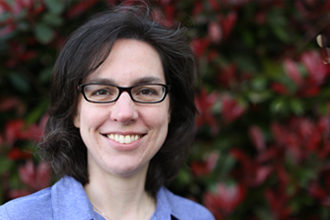INNOVATIVE TEACHING SHOWCASE
An Inquiry-Based Introduction to Proof in Number Theory
Introduction

When I came to Western eight years ago, I was excited to learn that Math 302: Introduction to Proof via Number Theory was one of a handful of courses in the department that were taught using a modified Moore method approach. R. L. Moore developed this style of teaching in mathematics courses first at the University of Pennsylvania in the 1910s, and later at the University of Texas at Austin. He didn't

Adopters of the modified Moore method often follow less strict rules; doing some lecturing, or allowing student collaboration, for instance, which Moore did not [1]. Recently there has been interest in the use of
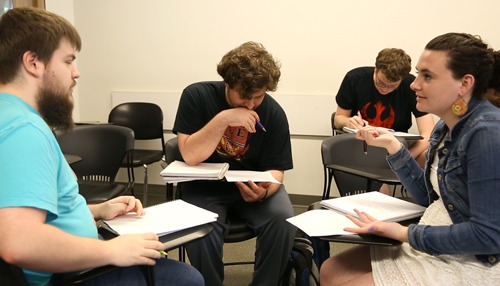
Though I'm clearly biased, I think number theory is the perfect area of study for an IBL course because many of the topics in a first course in number theory, such as divisibility of integers, greatest common divisors, and prime numbers, are already familiar to the students, at least informally. That familiarity makes students more comfortable playing around with new ideas that build upon what they already know.
When I was first assigned to teach Math 302, I was eager to experiment with the Moore method, which I'd had some limited experience with as an undergraduate, but I wanted to combine it with certain IBL elements. In keeping with the spirit of mathematical discovery, I wanted the theorems the students proved to come from their own investigations, to a certain extent. It is always a good idea to believe a theorem is true before you try to prove it. If the students were to recognize patterns themselves, and then frame them as theorems, I felt the proof work would be that much more meaningful. With the support of a Summer Teaching Grant, I spent a few months developing my own materials. I settled on a framework which requires students to first investigate topics through group worksheets to discover mathematical patterns, then formally prove these patterns exist and present their proofs to the class.
What is a proof?
Math 302: Introduction to Proof via Number Theory is a gateway into the major, and one of three courses required as a prerequisite to upper division classes that rely heavily on proof. As such, Math 302 serves two purposes: it introduces students to the nature of proof, and teaches them some number theory content. Learning to prove basic theorems is a rite of passage for math majors, and there is often a steep learning curve.
A proof uses logical inference to build on basic axioms, definitions, and already established facts to arrive at a desired conclusion. It must not only be logically sound and built upon a correct foundation, but be expressed clearly, precisely, and unambiguously. There is no algorithm one can follow to produce a proof, a point of frustration to some students. Proof is something you have to learn by doing. It takes a lot of practice reading and writing proofs to internalize the logical structure and the accepted style and conventions of the form, not to mention developing the intuition needed to arrive at a correct argument.

How is the class structured?
I have divided my course into a sequence of eight modules, each introducing a new topic that builds on the previous ones. Each module consists of a worksheet and a theorem set.
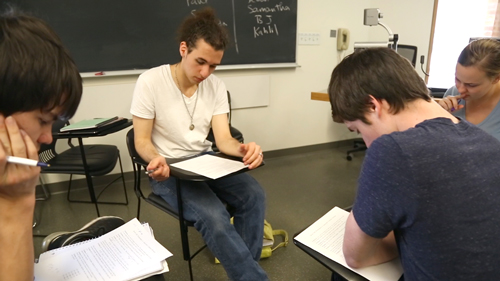
Once the class has completed their discussion of the worksheet, I distribute a list of theorems related to the worksheet content. The theorems formalize and expand on the knowledge discovered during the worksheet. The theorem set for modular exponentiation includes Fermat's Little Theorem, but because the proof of this theorem involves a couple of non-obvious steps, I have broken it into three separate statements which step through the proof (see theorem set). Students work outside of class to prove these theorems. They are allowed to work together but are encouraged to first try them on their own. My cardinal rule is that they are not allowed to consult sources other than me or their classmates (no textbooks, internet searches, or outside people). Then they present their proofs in class. Students either write their proof on the board or display an already-written proof via the document camera and orally

What is my role as an instructor?
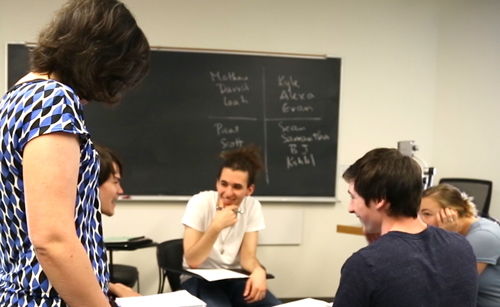
Group Communitcation Issues
Occasionally, I have to encourage group communication. This is most likely at the start of the quarter before the students have become used to our routine. If a group has been quiet, working
individually while sitting together, and one of the members asks me for help, I will ask him if he has checked with his group first. If the class as a whole is unusually quiet, I will remind
them to use each other as resources. Every once in a while a class may have an overabundance of timid students. If I sense that my presence is making them less likely to vocalize their thoughts,
I might actually leave the room for a few minutes to allow them to relax, and to emphasize that they are in charge of their own learning. Sometimes if I just sit down in an inconspicuous corner it is
enough for them to start talking.
Faciliating Class Discussion
When the groups have finished working through the problems, I facilitate a class discussion about their results. We have an opportunity to compare different-looking answers, refine understanding and clear
up any misinterpretations of the material. We also hopefully arrive at some conjectures we might then be able to prove as theorems.
Group Dynamics
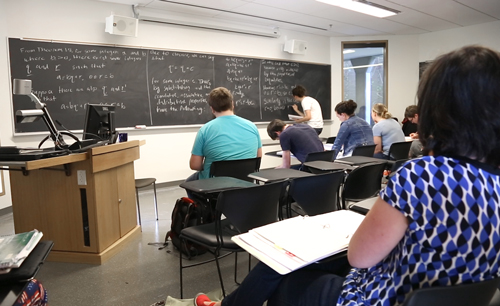
Student Presenters
During presentation days, I put the focus on the student presenters by sitting with the rest of the class. Students volunteer for proofs by signing up on a side board at the start of class.
If there is competition for a theorem, I give priority to those with the fewest previous presentations. I evaluate the proof and assess the presentation, but I defer to the students as much
as possible to identify errors or other issues. If there is something I think needs to be discussed that isn’t brought up by the students, I will try to point them in the right direction by
saying something like, "let’s take a look at this sentence again." General questions often come up and can be discussed organically during this time, particularly questions about notation,
writing conventions, and style.
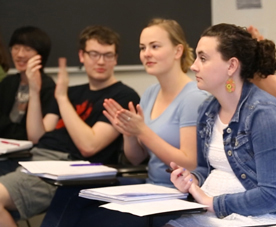
How do the students respond?
In order for my class to be successful, student buy-in is key. This class is very different than most math classes they have taken, and they need to have some level of trust that it is worth the effort. It's critical to have a core group of students who are willing to put in the time and struggle with proofs, and be not too afraid of making mistakes. I always tell my class on the first day (in fact it's in the syllabus) that it is okay, and expected, that they will be wrong, and make mistakes, and get stuck. I work hard to establish a culture in the classroom where all ideas are welcome and will be thoughtfully considered. I find that when students are providing feedback to their peers, they almost always do so in a supportive and positive way. They tend to develop a feeling that they are all in this together.When the class is running as it should, it is a dynamic environment. On worksheet days, students question each other, pop up to write on the boards, get frustrated, and have "a-ha" moments. On presentation days the class is clearly rooting for a presenter to give a successful proof. They make polite suggestions, and are apologetic when they have to point out a flaw. When they are satisfied with a proof, they applaud. On occasion I have days where no one is prepared to present theorems. Too many of these days can derail a class, so I have to make a judgment call. Are they working hard but stuck, or are they not putting in the time outside of class? Depending on the sense I get, I might spend a day letting them work on theorems in class, or lead a brainstorming session about one or two of the more critical theorems. It's a tricky balance, because if I lead them too much, I take away their ownership of the work and defeat the purpose of the class.
Most students come to see the value in my methods, even if they find the class difficult. They enjoy the collaboration with their peers, and recognize that they have learned a lot. The most common negative comments are from students who want more structure. They prefer to learn by following examples and wish I would lecture more, or summarize the content for them. They want more direction for how to get started on particular proofs. My response is that I don't expect everyone to be able to prove every theorem themselves, and their grade does not depend on it. Some proofs are clearly harder than others. But even if they don't get a particular proof themselves, there is still value in learning it from a peer, and then writing it down in their own words.
Reflections and Directions for the Future
I've been teaching this course now once or twice a year for six years. In that time, three of my colleagues have adopted my course materials and have found them to be very successful.
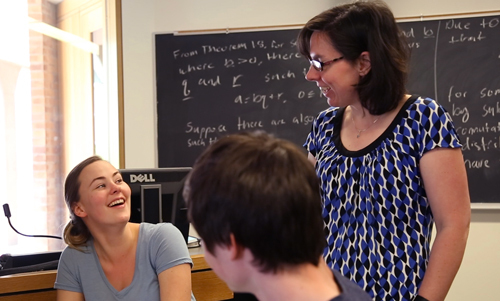
This approach is a good fit for my personality, as well. I'm not the most comfortable being the center of attention (though I've adapted to this over the last fifteen years in the classroom). I've always preferred small group or one-on-one interactions, so putting the focus on the students in class actually makes me feel most comfortable and allows me to capitalize on my strengths as a teacher.
Two potential drawbacks to using IBL that I often hear mentioned are the cost in time up front to build a course from scratch, and the fact that it is difficult to cover as much material as in a standard lecture course. While it does take substantial time to develop material for such a course, that time pays off down the road if you teach the course frequently, because there is much less prep work to be done during the term. There are also course packs freely available online through the peer-reviewed Journal of Inquiry-Based Learning in Mathematics [4], if you want to try out IBL without doing it from scratch. As for the amount of material, it's true that I probably cover fewer topics than a standard quarter-long number theory course, but I believe that by actively working through the material themselves, my students will better retain that which they do study. My hope is that the skills they develop in my class make them better learners of mathematics.
Moving forward, I continue to make minor revisions to the material each time I teach it. I would love to find the time to develop similar course materials for the two other proof courses I teach most often in discrete mathematics and abstract algebra. I have become convinced that IBL works best for me as teacher and, if they are willing to put the effort in, it is best for my students.
References and Resources
[1] The Academy of Inquiry-Based Learning,[2] C. A. Coppin, W. T. Mahavier, E. L. May and E. Parker,
The Mathematical Association of America, Washington, D. C., 2009.
[3] Inquiry-Based Learning in College Mathematics,
[4] Journal of Inquiry-Based Learning in Mathematics,
↑ Go to top


